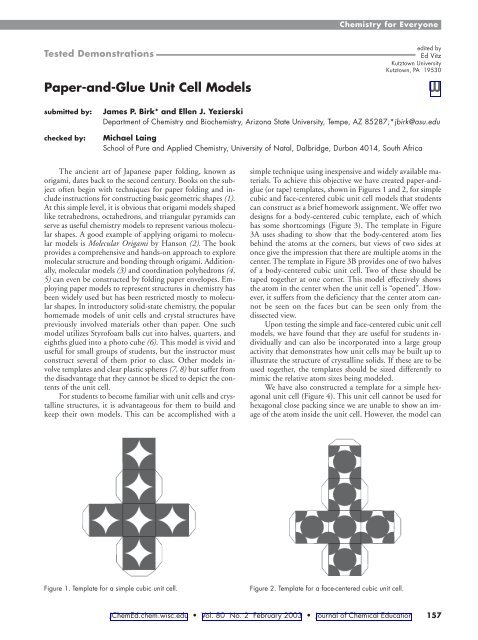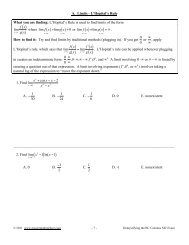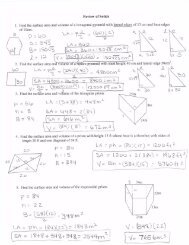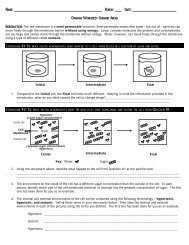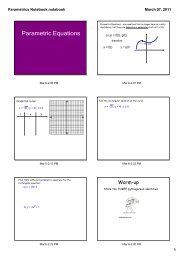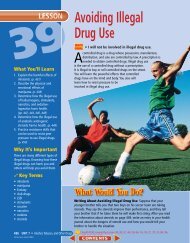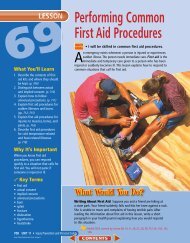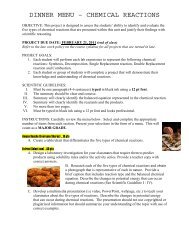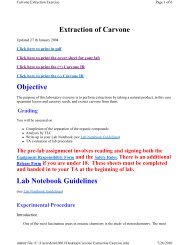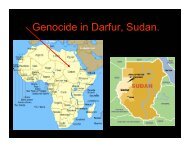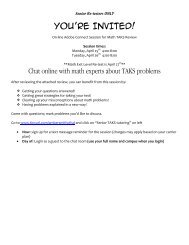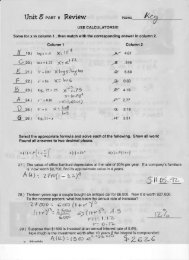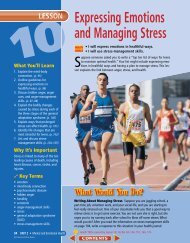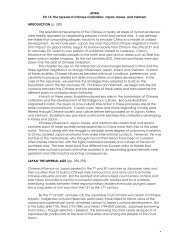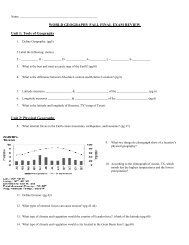Paper-and-Glue Unit Cell Models W
Paper-and-Glue Unit Cell Models W
Paper-and-Glue Unit Cell Models W
You also want an ePaper? Increase the reach of your titles
YUMPU automatically turns print PDFs into web optimized ePapers that Google loves.
Tested Demonstrations<br />
The ancient art of Japanese paper folding, known as<br />
origami, dates back to the second century. Books on the subject<br />
often begin with techniques for paper folding <strong>and</strong> include<br />
instructions for constructing basic geometric shapes (1).<br />
At this simple level, it is obvious that origami models shaped<br />
like tetrahedrons, octahedrons, <strong>and</strong> triangular pyramids can<br />
serve as useful chemistry models to represent various molecular<br />
shapes. A good example of applying origami to molecular<br />
models is Molecular Origami by Hanson (2). The book<br />
provides a comprehensive <strong>and</strong> h<strong>and</strong>s-on approach to explore<br />
molecular structure <strong>and</strong> bonding through origami. Additionally,<br />
molecular models (3) <strong>and</strong> coordination polyhedrons (4,<br />
5) can even be constructed by folding paper envelopes. Employing<br />
paper models to represent structures in chemistry has<br />
been widely used but has been restricted mostly to molecular<br />
shapes. In introductory solid-state chemistry, the popular<br />
homemade models of unit cells <strong>and</strong> crystal structures have<br />
previously involved materials other than paper. One such<br />
model utilizes Styrofoam balls cut into halves, quarters, <strong>and</strong><br />
eighths glued into a photo cube (6). This model is vivid <strong>and</strong><br />
useful for small groups of students, but the instructor must<br />
construct several of them prior to class. Other models involve<br />
templates <strong>and</strong> clear plastic spheres (7, 8) but suffer from<br />
the disadvantage that they cannot be sliced to depict the contents<br />
of the unit cell.<br />
For students to become familiar with unit cells <strong>and</strong> crystalline<br />
structures, it is advantageous for them to build <strong>and</strong><br />
keep their own models. This can be accomplished with a<br />
Chemistry for Everyone<br />
<strong>Paper</strong>-<strong>and</strong>-<strong>Glue</strong> <strong>Unit</strong> <strong>Cell</strong> <strong>Models</strong> W<br />
submitted by: James P. Birk* <strong>and</strong> Ellen J. Yezierski<br />
Department of Chemistry <strong>and</strong> Biochemistry, Arizona State University, Tempe, AZ 85287;*jbirk@asu.edu<br />
checked by: Michael Laing<br />
School of Pure <strong>and</strong> Applied Chemistry, University of Natal, Dalbridge, Durban 4014, South Africa<br />
Figure 1. Template for a simple cubic unit cell.<br />
edited by<br />
Ed Vitz<br />
Kutztown University<br />
Kutztown, PA 19530<br />
simple technique using inexpensive <strong>and</strong> widely available materials.<br />
To achieve this objective we have created paper-<strong>and</strong>glue<br />
(or tape) templates, shown in Figures 1 <strong>and</strong> 2, for simple<br />
cubic <strong>and</strong> face-centered cubic unit cell models that students<br />
can construct as a brief homework assignment. We offer two<br />
designs for a body-centered cubic template, each of which<br />
has some shortcomings (Figure 3). The template in Figure<br />
3A uses shading to show that the body-centered atom lies<br />
behind the atoms at the corners, but views of two sides at<br />
once give the impression that there are multiple atoms in the<br />
center. The template in Figure 3B provides one of two halves<br />
of a body-centered cubic unit cell. Two of these should be<br />
taped together at one corner. This model effectively shows<br />
the atom in the center when the unit cell is “opened”. However,<br />
it suffers from the deficiency that the center atom cannot<br />
be seen on the faces but can be seen only from the<br />
dissected view.<br />
Upon testing the simple <strong>and</strong> face-centered cubic unit cell<br />
models, we have found that they are useful for students individually<br />
<strong>and</strong> can also be incorporated into a large group<br />
activity that demonstrates how unit cells may be built up to<br />
illustrate the structure of crystalline solids. If these are to be<br />
used together, the templates should be sized differently to<br />
mimic the relative atom sizes being modeled.<br />
We have also constructed a template for a simple hexagonal<br />
unit cell (Figure 4). This unit cell cannot be used for<br />
hexagonal close packing since we are unable to show an image<br />
of the atom inside the unit cell. However, the model can<br />
Figure 2. Template for a face-centered cubic unit cell.<br />
JChemEd.chem.wisc.edu • Vol. 80 No. 2 February 2003 • Journal of Chemical Education 157
Chemistry for Everyone<br />
be used to show the packing in the hexagonal crystal system.<br />
Note that the hexagonal unit cell has no 6-fold axis, but 3fold<br />
<strong>and</strong> 2-fold axes are easy to identify from the models.<br />
Students can compare the number of unit cells required to<br />
make up a full atom in comparison to the cubic systems (6<br />
vs 8 unit cells).<br />
Finally, we have constructed a unit cell template for the<br />
sodium chloride structure (Figure 5). This unit cell shows<br />
the packing pattern very nicely but has a deficiency in that<br />
the ion at the body-centered position ( 1 /2, 1 /2, 1 /2) is not visible.<br />
Thus, students cannot use this model to correctly count<br />
the number of ions per unit cell.<br />
Full-sized versions of the templates, which can be printed<br />
on 8.5-in. × 11-in. paper <strong>and</strong> result in cube sides of about 6<br />
cm, may be found on JCE Online. W Students cut out the figure<br />
<strong>and</strong> fold the paper along each of the lines. The tabs are<br />
then glued inside the cube. The unit cells are easy for students<br />
to construct <strong>and</strong> can be used in high school <strong>and</strong> college<br />
chemistry courses.<br />
The cubic paper-<strong>and</strong>-glue templates (Figures 1 <strong>and</strong> 2)<br />
were designed to help students underst<strong>and</strong> the structure of<br />
cubic unit cells in the context of a crystalline solids unit of<br />
instruction. We have incorporated the models into an intro-<br />
A<br />
B<br />
Figure 3. Templates for body-centered cubic unit cell.<br />
duction to crystalline solids in our general chemistry lecture<br />
course. One lecture before introducing solid-state chemistry,<br />
we h<strong>and</strong> out the template sheets to the students. We tell the<br />
students to cut them out, to tape or glue them into cubes,<br />
<strong>and</strong> to bring the assembled models to the next lecture (Figure<br />
6). <strong>Glue</strong> sticks provide the simplest approach to fastening<br />
the sides to the tabs during assembly of the models.<br />
Most of the students cooperate <strong>and</strong> arrive with their<br />
models in h<strong>and</strong>. We show microscopic diagrams <strong>and</strong> animations<br />
of various crystalline solids <strong>and</strong> discuss the structures<br />
of the unit cells that comprise these solids. When we introduce<br />
the simple cubic <strong>and</strong> face-centered cubic unit cells, the<br />
students bring their models to the front of the lecture hall<br />
<strong>and</strong> add their models to others to build three-dimensional<br />
crystalline solids (Figure 7).<br />
Even with 200 students, this can be done in 5–10<br />
minutes. Not only is the model effective at showing how the<br />
eighths, quarters, <strong>and</strong> halves make up whole spheres in the<br />
crystal, students are also more involved in creating the model.<br />
Additionally, students can examine the holes in the structure<br />
(white areas) <strong>and</strong> consider how the structure of the unit cell<br />
dictates the shape of a particular hole (cubic, octahedral, or<br />
tetrahedral). We then invite the students to take their cubes<br />
Figure 4. Template for a hexagonal unit cell.<br />
Figure 5. Template for a sodium chloride unit cell.<br />
158 Journal of Chemical Education • Vol. 80 No. 2 February 2003 • JChemEd.chem.wisc.edu
Figure 6. Face-centered <strong>and</strong> simple cubic unit cell paper-<strong>and</strong>-glue<br />
models.<br />
with them at the end of the class to use as they study the<br />
lecture material. We also recommend that they use the models<br />
when they study crystalline structures in the laboratory<br />
component of the course.<br />
The general chemistry students at our university build<br />
various solids in the lab using the ICE model kit (7). Based<br />
on student responses in their lab reports, the investigation is<br />
moderately successful; however, the students still have difficulty<br />
visually “slicing” the spheres in the kit in order to identify<br />
the type of unit cell in each of the structures. Students<br />
report that the paper models from lecture help them to identify<br />
unit cells <strong>and</strong> visualize them when looking at a model of<br />
a crystalline solid. We have also used animations designed<br />
by members of our research group to show how atoms in<br />
crystal structures are “sliced” into unit cells.<br />
Assembling the unit cell models to form a model of a<br />
crystal enables the students to participate in a large group<br />
activity. They also have a personal h<strong>and</strong>s-on model to examine<br />
before, during, <strong>and</strong> after lecture as well as a threedimensional<br />
model showing the arrangement of atoms in<br />
unit cells.<br />
Acknowledgments<br />
We thank Rachel Morgan of Arizona State University<br />
<strong>and</strong> Michael Laing of the University of Natal for suggestions<br />
regarding the dissectable version of the unit cell for the bodycentered<br />
cubic unit cell.<br />
Chemistry for Everyone<br />
Figure 7. Model of crystalline solid structure built from face-centered<br />
cubic paper-<strong>and</strong>-glue unit cells.<br />
This work was supported in part by the National Science<br />
Foundation under grant no. DUE 9453610 <strong>and</strong> the<br />
U. S. Department of Education under grant no. OPE<br />
P336B990064. Opinions, findings, <strong>and</strong> conclusions or recommendations<br />
expressed in this publication are those of the<br />
authors <strong>and</strong> do not necessarily reflect the views of the National<br />
Science Foundation or the Department of Education.<br />
W Supplemental Material<br />
Full-sized versions of the templates, which can be printed<br />
on 8.5-in. × 11-in. paper <strong>and</strong> result in cube sides of about<br />
6 cm, are available on JCE Online.<br />
Literature Cited<br />
1. Kasahara, K. Origami Omnibus; Japan Publications, Inc.: Tokyo,<br />
1988.<br />
2. Hanson, R. M. Molecular Origami; University Science Books:<br />
California, 1996.<br />
3. Yamana, S. J. Chem. Educ. 1988, 65, 1074.<br />
4. Yamana, S. J. Chem. Educ. 1987, 64, 1033.<br />
5. Yamana, S. J. Chem. Educ. 1987, 6, 1040.<br />
6. Olsen, R.; Tobiason, F. J. Chem. Educ. 1975, 52, 509.<br />
7. Mayer, L.; Lisensky, G. Solid State Model Kit, version 4.0, ICE<br />
Publication No. 94-004; Institute for Chemical Education:<br />
Madison, Wisconsin, 1994.<br />
8. Laing, M. J. Chem. Educ. 1997, 74, 795.<br />
JChemEd.chem.wisc.edu • Vol. 80 No. 2 February 2003 • Journal of Chemical Education 159


